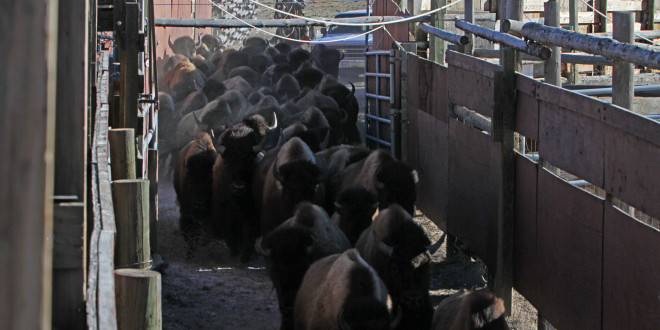Bison operations are slated to begin as expected at the Stephens Creek Bison Capture Facility February 15 and go through to the end of March.
Currently, the Interagency Bison Management Plan is seeking to remove 600 to 900 bison from the Yellowstone herd, in the hopes of decreasing the population to a target of 3,000. The current population estimate is closer to 4,000-plus animals.
“Federal, state, and tribal members of the IBMP have agreed to use hunting as the primary method for removing bison from the population,” according to a Yellowstone press release “and this activity has removed more than 300 animals this winter through treaty and public hunting outside the park. That number will not be enough to manage for a decreasing population, so additional animals will be captured at Stephens Creek and transferred to tribal groups for processing and distribution of meat and other parts to their members for nutrition and cultural practices. Tribal hunts are anticipated to continue during the operations at Stephens Creek.”
Stephens Creek, of course, is currently at the heart of a lawsuit aimed at allowing unfettered access to the facility by the public. The plaintiffs in the lawsuit had previously called for an injunction halting operations at Stephens Creek, which was not granted at a hearing held last week.
Normally, parts of Yellowstone National Park are closed to the public, in and around the Stephens creek area. The NPS has released a map of closures in the Park for free, available here through the Service’s website.
Although bison operations are slated to continue as is this year, there are signs that bison management in Yellowstone could be changing dramatically. From a Yellowstone press release:
A tour of the Stephens Creek facility for media and stakeholders was held on January 20, 2016 during which participants were provided the opportunity to understand the operations at the facility and to spend time with subject matter experts for questions and clarification. Two opportunities to view operations will occur between February 15 and March 15 for media and stakeholders who have signed up.
The NPS values bison because they are a native wildlife species. They play an important role in preserving the ecological processes of the greater Yellowstone area. Migration is a key element of bison ecology that shapes how they influence our system. In fact, they now have access to the entire habitat we manage and preserve in Yellowstone National Park.
The NPS continues to look for alternative ways to manage bison. For example, the NPS and the State of Montana are working together on a large planning effort to replace the current bison management plan (IBMP). The NPS also released an environmental assessment for public comment on January 13, 2016 to allow for Yellowstone bison to be quarantined and used to establish or augment populations elsewhere.
Coupled with Montana Governor Steve Bullock’s intent to allow bison year-round in parts of southern and southwestern Montana, these announcements could spell the end—or, at the very least, the decline—of bison operations at Stephens Creek. It all depends on what the IBMP partners decide.
 Yellowstone Insider Your Complete Guide to America's First National Park
Yellowstone Insider Your Complete Guide to America's First National Park





